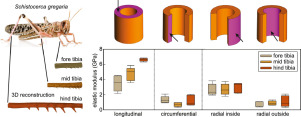当前位置:
X-MOL 学术
›
Acta Biomater.
›
论文详情
Our official English website, www.x-mol.net, welcomes your
feedback! (Note: you will need to create a separate account there.)
Cuticle sclerotization determines the difference between the elastic moduli of locust tibiae.
Acta Biomaterialia ( IF 9.4 ) Pub Date : 2019-12-13 , DOI: 10.1016/j.actbio.2019.12.013 Chuchu Li 1 , Stanislav N Gorb 1 , Hamed Rajabi 1
Acta Biomaterialia ( IF 9.4 ) Pub Date : 2019-12-13 , DOI: 10.1016/j.actbio.2019.12.013 Chuchu Li 1 , Stanislav N Gorb 1 , Hamed Rajabi 1
Affiliation

|
A striking characteristic of insect cuticle is the wide range of its material property values, with respect to stiffness, strength and toughness. The elastic modulus of cuticle, for instance, ranges over seven orders of magnitude in different structures and different species. Previous studies suggested that this characteristic is influenced by the microstructure and sclerotization of cuticle. However, the relative role of the two factors in determining the material properties of cuticle is unknown. Here we used a combination of scanning electron microscopy (SEM), confocal laser scanning microscopy (CLSM) and nanoindentation, to investigate the effect of microstructure and sclerotization on the elastic modulus of tibiae of desert locusts. Our results showed that tibial cuticle is an anisotropic material with the highest elastic modulus along the tibial axis. This is likely because majority of the fibers in the cuticle are oriented along this axis. We also found that the hind tibia has a significantly higher elastic modulus, compared with the fore and mid tibiae. This is likely due to the higher sclerotization level of the hind tibia cuticle, and seems to be an adaptation to the locust locomotion by jumping, in which axial loads in the hind tibiae may reach several times the insect body weight. Our results suggest that while sclerotization determines the difference between the elastic moduli of the tibiae, anisotropic properties of each tibia is controlled by the specific fiber orientation. Our study provides one of only a few comprehensive investigations on insect cuticle, and helps to better understand the structure-material-function relationship in this complex biological composite. STATEMENT OF SIGNIFICANCE: Insect cuticle is a biological composite with strong anisotropy and wide ranges of material properties. Using an example of the tibial cuticle of desert locusts, we examined the role of two influential factors on the elastic modulus of cuticle: microstructure and sclerotization. Our results suggested the strong influence of sclerotization on the variation of the elastic modulus among fore, mid and hind tibiae, and that of the microstructure on the anisotropy of each tibia. Our results deepens the current understanding of the structure-material-function relationship in complex insect cuticle.
中文翻译:

角质层的硬化决定了蝗虫胫骨的弹性模量之间的差异。
昆虫角质层的显着特征是其硬度,强度和韧性方面的材料特性值范围广泛。例如,在不同的结构和不同的物种中,表皮的弹性模量范围超过七个数量级。先前的研究表明,该特性受角质层的微观结构和硬化作用的影响。然而,这两个因素在决定表皮材料特性方面的相对作用尚不清楚。在这里,我们结合使用扫描电子显微镜(SEM),共聚焦激光扫描显微镜(CLSM)和纳米压痕技术,研究了显微结构和硬化过程对沙漠蝗虫胫骨弹性模量的影响。我们的结果表明,胫骨表皮是一种各向异性的材料,沿胫骨轴的弹性模量最高。这可能是因为表皮中的大部分纤维都沿着该轴取向。我们还发现,与前胫骨和中胫骨相比,后胫骨的弹性模量明显更高。这可能是由于后胫骨角质层的硬化程度较高,并且似乎是通过跳跃适应蝗虫运动的,其中后胫骨中的轴向负荷可能达到昆虫体重的几倍。我们的研究结果表明,虽然硬化过程决定了胫骨的弹性模量之间的差异,但每个胫骨的各向异性属性是由特定的纤维方向控制的。我们的研究是对昆虫角质层的仅有的几项全面研究之一,并有助于更好地了解这种复杂生物复合物中的结构-材料-功能关系。意义声明:昆虫表皮是一种生物复合材料,具有很强的各向异性和广泛的材料特性。以沙漠蝗虫胫骨表皮为例,我们研究了两个影响表皮弹性模量的因素:微观结构和硬化。我们的研究结果表明硬化对胫骨前,中,后胫骨弹性模量变化的强烈影响,以及微观结构对每个胫骨各向异性的影响。我们的结果加深了目前对复杂昆虫表皮中结构-材料-功能关系的了解。意义声明:昆虫表皮是一种生物复合材料,具有很强的各向异性和广泛的材料特性。以沙漠蝗虫胫骨表皮为例,我们研究了两个影响表皮弹性模量的因素:微观结构和硬化。我们的研究结果表明硬化对胫骨前,中,后胫骨弹性模量变化的强烈影响,以及微观结构对每个胫骨各向异性的影响。我们的结果加深了目前对复杂昆虫表皮中结构-材料-功能关系的了解。意义声明:昆虫表皮是一种生物复合材料,具有很强的各向异性和广泛的材料特性。以沙漠蝗虫胫骨表皮为例,我们研究了两个影响表皮弹性模量的因素:微观结构和硬化。我们的研究结果表明硬化对胫骨前,中,后胫骨弹性模量变化的强烈影响,以及微观结构对每个胫骨各向异性的影响。我们的结果加深了目前对复杂昆虫表皮中结构-材料-功能关系的了解。我们研究了两个影响角质层弹性模量的因素:微观结构和硬化。我们的研究结果表明硬化对胫骨前,中,后胫骨弹性模量变化的强烈影响,以及微观结构对每个胫骨各向异性的影响。我们的结果加深了目前对复杂昆虫表皮中结构-材料-功能关系的了解。我们研究了两个影响角质层弹性模量的因素:微观结构和硬化。我们的研究结果表明硬化对胫骨前,中,后胫骨弹性模量变化的强烈影响,以及微观结构对每个胫骨各向异性的影响。我们的结果加深了目前对复杂昆虫表皮中结构-材料-功能关系的了解。
更新日期:2019-12-13
中文翻译:

角质层的硬化决定了蝗虫胫骨的弹性模量之间的差异。
昆虫角质层的显着特征是其硬度,强度和韧性方面的材料特性值范围广泛。例如,在不同的结构和不同的物种中,表皮的弹性模量范围超过七个数量级。先前的研究表明,该特性受角质层的微观结构和硬化作用的影响。然而,这两个因素在决定表皮材料特性方面的相对作用尚不清楚。在这里,我们结合使用扫描电子显微镜(SEM),共聚焦激光扫描显微镜(CLSM)和纳米压痕技术,研究了显微结构和硬化过程对沙漠蝗虫胫骨弹性模量的影响。我们的结果表明,胫骨表皮是一种各向异性的材料,沿胫骨轴的弹性模量最高。这可能是因为表皮中的大部分纤维都沿着该轴取向。我们还发现,与前胫骨和中胫骨相比,后胫骨的弹性模量明显更高。这可能是由于后胫骨角质层的硬化程度较高,并且似乎是通过跳跃适应蝗虫运动的,其中后胫骨中的轴向负荷可能达到昆虫体重的几倍。我们的研究结果表明,虽然硬化过程决定了胫骨的弹性模量之间的差异,但每个胫骨的各向异性属性是由特定的纤维方向控制的。我们的研究是对昆虫角质层的仅有的几项全面研究之一,并有助于更好地了解这种复杂生物复合物中的结构-材料-功能关系。意义声明:昆虫表皮是一种生物复合材料,具有很强的各向异性和广泛的材料特性。以沙漠蝗虫胫骨表皮为例,我们研究了两个影响表皮弹性模量的因素:微观结构和硬化。我们的研究结果表明硬化对胫骨前,中,后胫骨弹性模量变化的强烈影响,以及微观结构对每个胫骨各向异性的影响。我们的结果加深了目前对复杂昆虫表皮中结构-材料-功能关系的了解。意义声明:昆虫表皮是一种生物复合材料,具有很强的各向异性和广泛的材料特性。以沙漠蝗虫胫骨表皮为例,我们研究了两个影响表皮弹性模量的因素:微观结构和硬化。我们的研究结果表明硬化对胫骨前,中,后胫骨弹性模量变化的强烈影响,以及微观结构对每个胫骨各向异性的影响。我们的结果加深了目前对复杂昆虫表皮中结构-材料-功能关系的了解。意义声明:昆虫表皮是一种生物复合材料,具有很强的各向异性和广泛的材料特性。以沙漠蝗虫胫骨表皮为例,我们研究了两个影响表皮弹性模量的因素:微观结构和硬化。我们的研究结果表明硬化对胫骨前,中,后胫骨弹性模量变化的强烈影响,以及微观结构对每个胫骨各向异性的影响。我们的结果加深了目前对复杂昆虫表皮中结构-材料-功能关系的了解。我们研究了两个影响角质层弹性模量的因素:微观结构和硬化。我们的研究结果表明硬化对胫骨前,中,后胫骨弹性模量变化的强烈影响,以及微观结构对每个胫骨各向异性的影响。我们的结果加深了目前对复杂昆虫表皮中结构-材料-功能关系的了解。我们研究了两个影响角质层弹性模量的因素:微观结构和硬化。我们的研究结果表明硬化对胫骨前,中,后胫骨弹性模量变化的强烈影响,以及微观结构对每个胫骨各向异性的影响。我们的结果加深了目前对复杂昆虫表皮中结构-材料-功能关系的了解。











































 京公网安备 11010802027423号
京公网安备 11010802027423号